Cascadia Research will be undertaking a 17-day collaborative field project with researchers from Woods Hole Oceanographic Institution off the island of Hawai‘i starting August 9th, 2012. The primary purpose of the project is to obtain information on diving and acoustic behavior of false killer whales and melon-headed whales through the deployment of suction-cup attached digitial acoustic tags (Dtags), continuing work started last October. We’ll also have a second boat on the water during this period to allow us to survey a broader area off the Kona coast each day and we’ll be trying to deploy satellite tags on several species to examine movements and habitat use. Like all of our projects we’ll also be obtaining photos from most species of odontocetes we encounter, to contribute to ongoing studies of residency patterns and social organization and to estimate population sizes, and collecting biopsy samples for toxicology and genetic studies.
The research team includes Aran Mooney from Woods Hole Oceanographic Institution, Daniel Webster, Jessica Aschettino, and Robin Baird of Cascadia, Jeff Hogan of Killer Whale Tales, Renee Albertson of Oregon State University, Dan McSweeeney of the Wild Whale Research Foundation, and a number of visiting researchers and volunteers. This work is primarily being funded by a grant from the Office of Naval Research, as well as a grant from the Pacific Islands Fisheries Science Center.
End of project updates
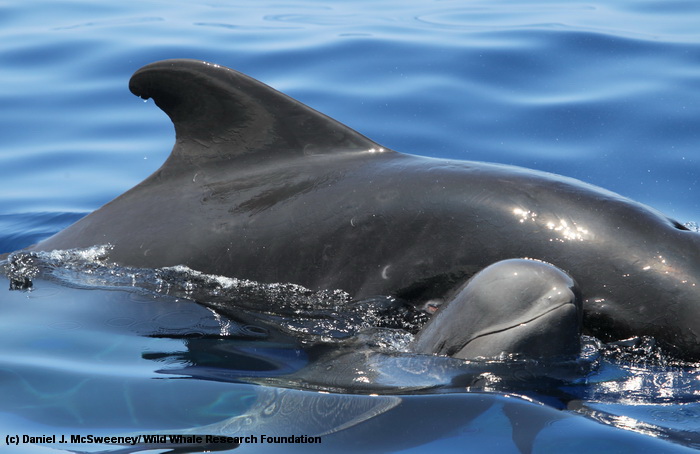
Short-finned pilot whale mother and neonate, August 30, 2012. Photo (c) Dan McSweeney.
Although our dual-boat effort ended on August 25th, we had an additional three days of effort with a single boat off Kona, ending the field project on August 31st. Between the two boats we had 36 “boat days” on the water and covered over 4,000 kilometers of trackline. During this effort we had 104 encounters with 9 species of odontocetes, including one seen very rarely (Risso’s dolphins), and three encounters with another rarely seen species, pygmy killer whales. What was most surprising about the trip was the complete lack of sightings of dwarf sperm whales – in our last two projects off of Kona we had 21 sightings of dwarf or pygmy sperm whales in 53 days of effort, and typically they have been our fifth-most frequently encountered species, so the complete lack of sightings was surprising, to say the least. We also had only one confirmed beaked whale sighting, whereas typically we encounter beaked whales an average of about once every five days on the water off Kona.
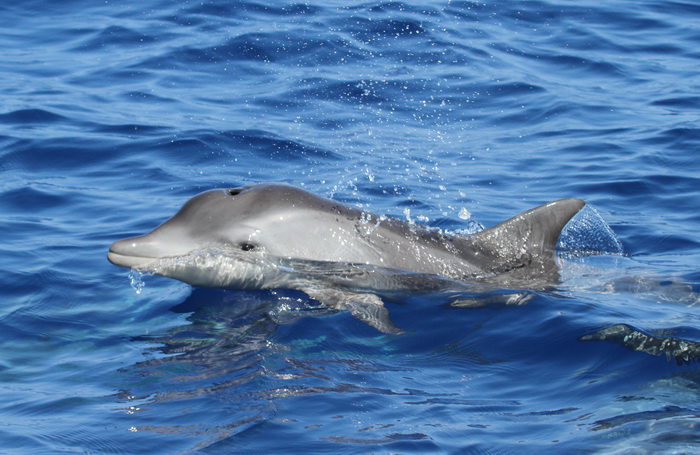
Rough-toothed dolphin, August 30, 2012. Photo (c) Jessica Aschettino. We did have higher than normal encounter rates of rough-toothed dolphins, with 18 sightings for the trip.
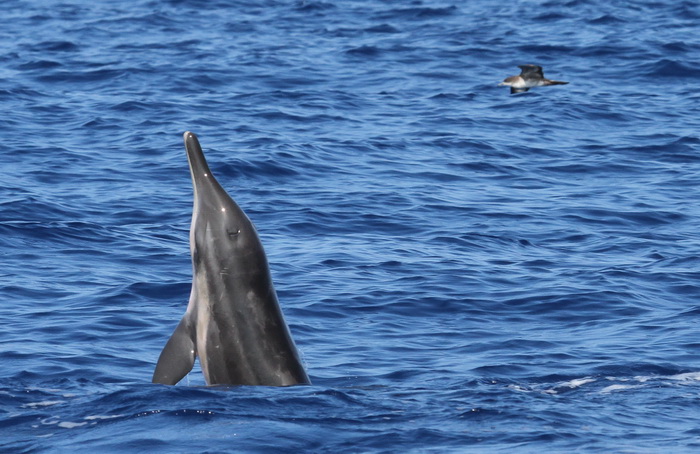
Rough-toothed dolphin, August 30, 2012. Photo (c) Jessica Aschettino.
Overall we collected 35 biopsy samples, took over 43,000 photographs, made numerous acoustic recordings, deployed (and recovered) several dTags (on pilot whales and melon-headed whales), and deployed two satellite tags (on melon-headed whales, including one location/dive tag). Overall a very successful trip.
August 24th update
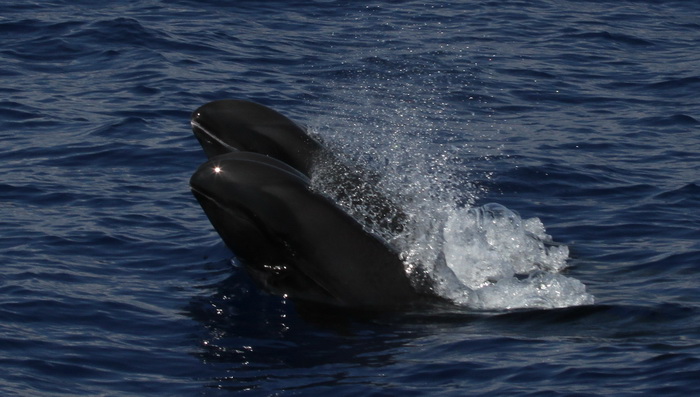
Melon-headed whales, August 24, 2012. Photo (c) Renee Albertson. Today was our most productive day on the water this trip – we encountered a group of about 350 melon-headed whales from the Hawaii Island resident population, were able to deploy (and recover) several Dtags, and also deployed two satellite-tags, including one location/dive tag, that should give us information on the depths and durations of dives as well as locations of the tagged individual.
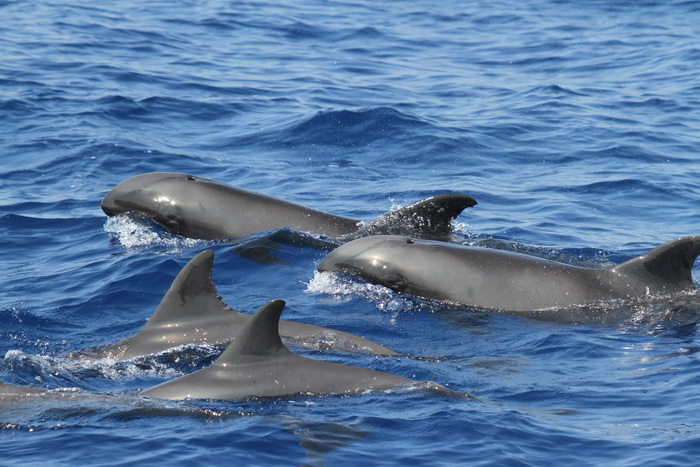
Melon-headed whales, August 24, 2012. Photo (c) Annie Gorgone
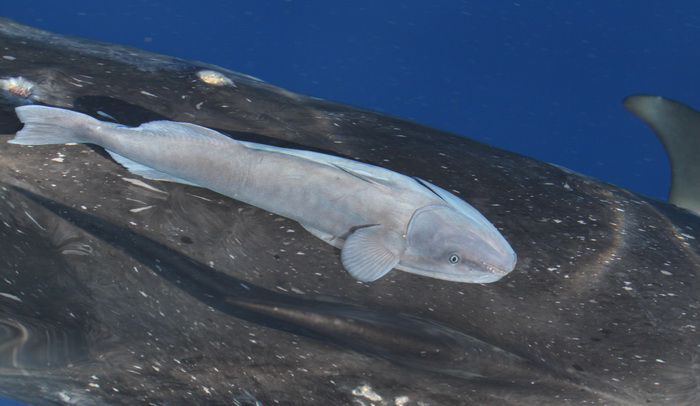
A remora on an adult female pantropical spotted dolphin, August 24, 2012. Photo (c) Jessica Aschettino.
August 22nd update

A short-finned pilot whale and the BURP (Biological Underwater Recording Package) developed by Jay Barlow at the Southwest Fisheries Science Center. Photo (c) Dan McSweeney, August 22, 2012. We are using the BURP to obtain acoustic recordings, focusing on pilot whales, for research being undertaken on acoustic differences among pilot whale groups by Amy Van Cise at Scripps Institution of Oceanography.

Pygmy killer whale, August 22, 2012. Photo (c) Aran Mooney. We also encountered our second group of pygmy killer whales for this trip, a group of five individuals. Four of the five individuals had previously been documented, off the island of O‘ahu, in 2007, 2008 and/or 2009 (three times by the Wild Dolphin Foundation and once by The Dolphin Institute). This is the second group of individual pygmy killer whales documented moving between O‘ahu and Hawai‘i Island, although in both cases the groups were not seen with any of the “resident” individuals from either island.
August 20th update
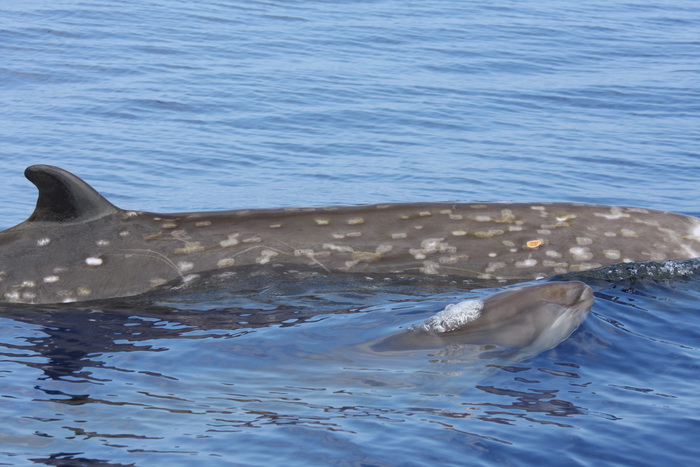
A Cuvier’s beaked whale mother and calf, August 20, 2012. Photo (c) Renee Albertson. Today we encountered our 9th species of odontocete for the trip, a pair of Cuvier’s beaked whales. The adult female, HIZc0018 in our photo-identification catalog, was first documented off the island in 2002 (actually the first Cuvier’s beaked whale we ever suction-cup tagged with a time-depth recorder), and again in 2010. She had a calf with her today, estimated to be about a year old based on the healed scars caused by cookie-cutter sharks. For more information on Cuvier’s beaked whales in Hawaii see our web page for beaked whales.
August 19th update
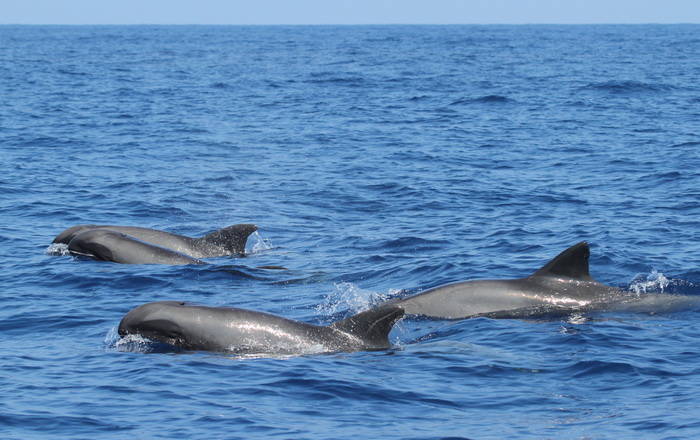
Melon-headed whales, August 19, 2012. Photo (c) Jessica Aschettino. Today we encountered our 8th species of odontocete for the trip, a group of about 25 melon-headed whales. This was a relatively small group for this species, which typically occurs in groups of several hundreds (the largest group we’ve encountered of melon-headed whales was ~800 individuals). We were able to obtain photos of all the individuals present and obtained two biopsy samples for genetic studies. From previous work we know there are at least two poulations of melon-headed whales in the area, one that is resident to the island of Hawaii, and one that moves among the islands and into offshore waters. We’ve compared some of the photos from today to our catalog but have not found matches to either population, so suspect these individuals may be from an open-ocean population. For more information on melon-headed whales in Hawaii see our web page for that species.
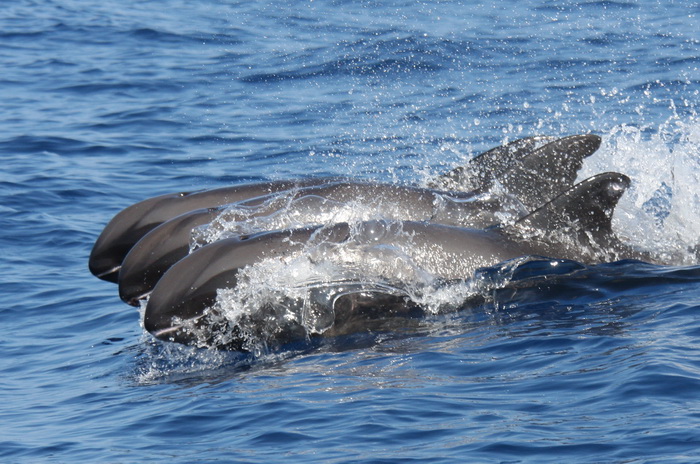
Melon-headed whales, August 19, 2012. Photo (c) Renee Albertson.
August 18th update
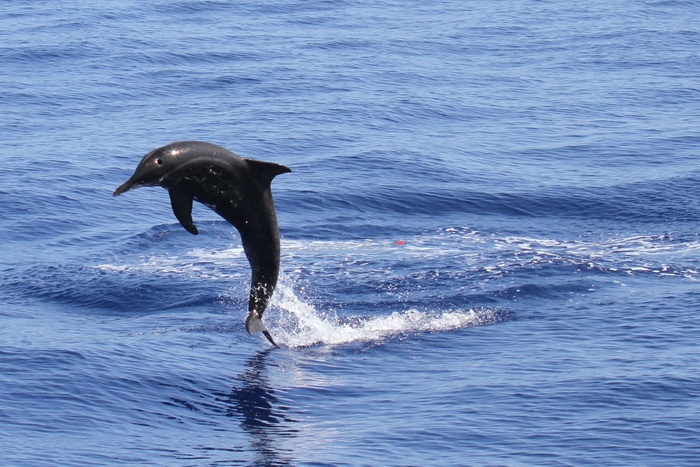
A rough-toothed dolphin leaping, August 18, 2012. Photo (c) Amy Van Cise
We’ve had a few fairly productive days on the water, with encounters with rough-toothed dolphins, short-finned pilot whales, and spotted dolphins, but surprising still no encounters with beaked whales or dwarf sperm whales, despite a combined 19 days on the water between the two boats. As well as obtaining identification photos of many individuals and a number of acoustic recordings, since the start of the trip we’ve collected 18 biopsy samples for genetic studies, one of a rough-toothed dolphin and 17 of short-finned pilot whales. The short-finned pilot whale biopsy samples are being collected for a study of population structure within the Pacific by Amy Van Cise, a Ph.D. student at Scripps Institution of Oceanography.
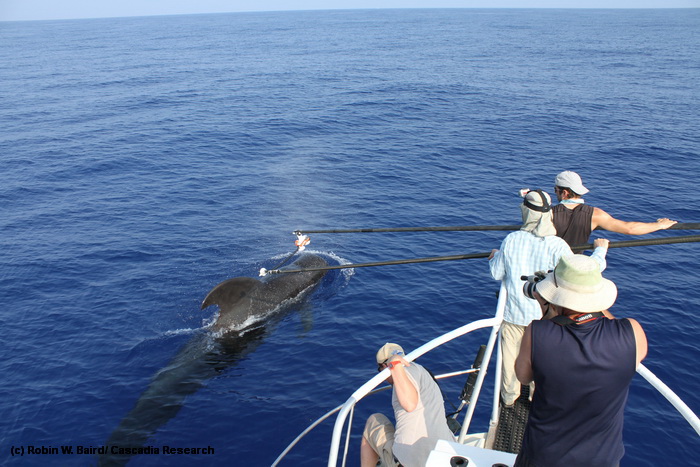
We’ve also attempted to deploy an ECG tag, developed by Russ Andrews of the University of Alaska Fairbanks/Alaska SeaLife Center, on a short-finned pilot whale, as well as one DTag, on August 16, 2012. Photo (c) Robin Baird.
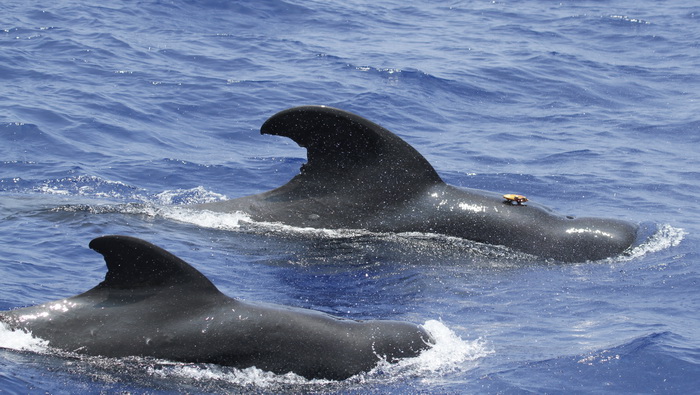
An adult male short-finned pilot whale with a suction-cup attached Dtag. Photo (c) Aran Mooney
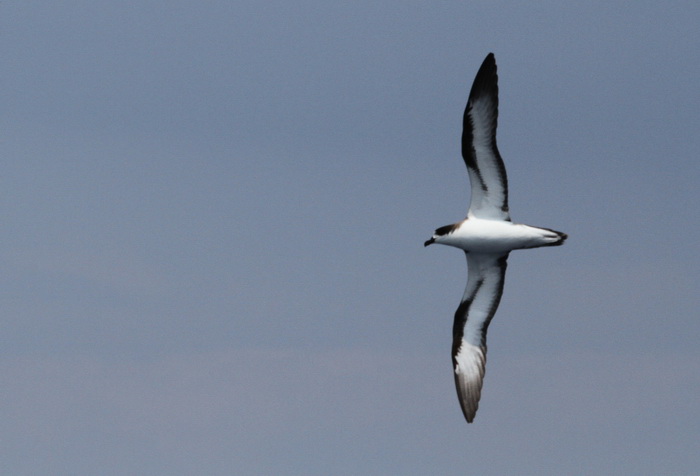
A Hawaiian petrel, August 16, 2012. Photo (c) Jeff Hogan
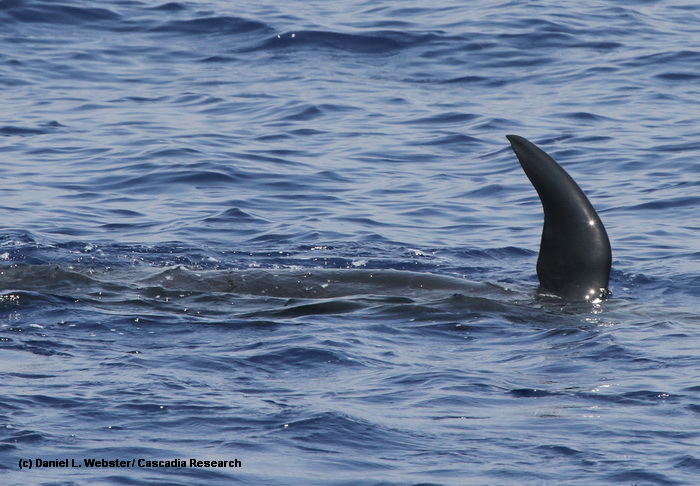
A short-finned pilot whale on its side with it’s pectoral flipper in the air, August 15, 2012. Photo (c) Daniel Webster

Pantropical spotted dolphin mother and calf bowriding, August 14, 2012. Photo (c) Daniel Webster
August 13th update
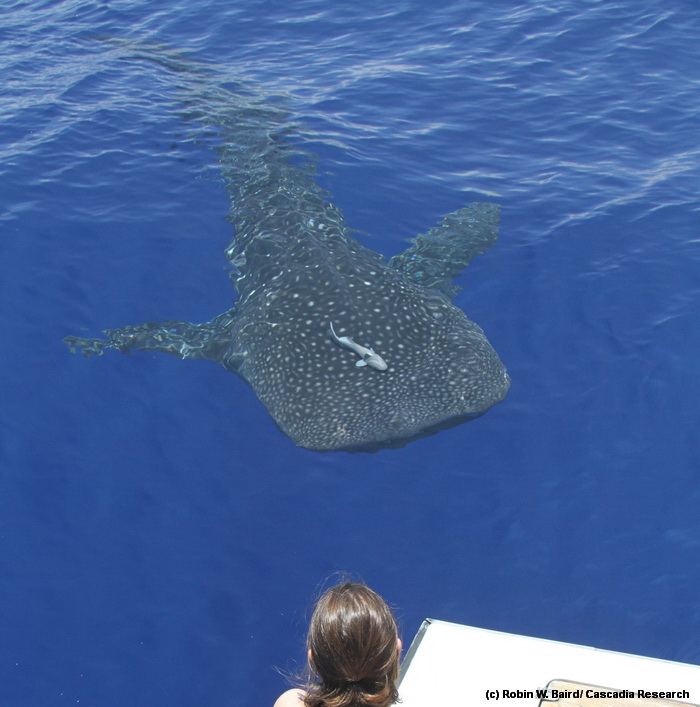
Whale shark approaching the R/V Wild Whale, August 13, 2012, with a remora on the head. Photo (c) Robin Baird. Although not a cetacean sighting, the highlight of our last two days was a close encounter with a whale shark – only our second-ever encounter with a whale shark in Hawai‘i and the first time many of the people on board had ever seen a whale shark. This individual circled our boat for almost half an hour.

Whale shark approaching the R/V Wild Whale, August 13, 2012. Photo (c) Robin Baird
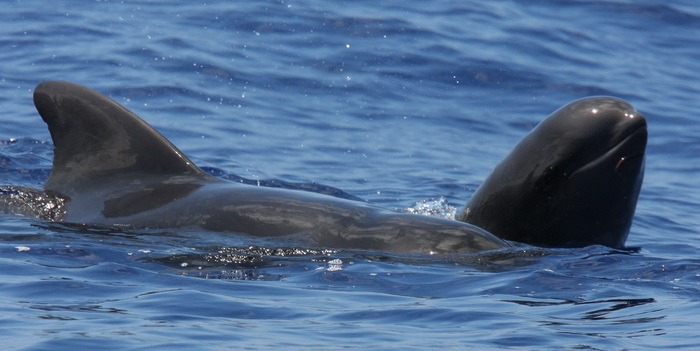
Short-finned pilot whales, August 12, 2012. Photo (c) Susan Rickards. The individual spyhopping on the right has a small remora on it’s chin.
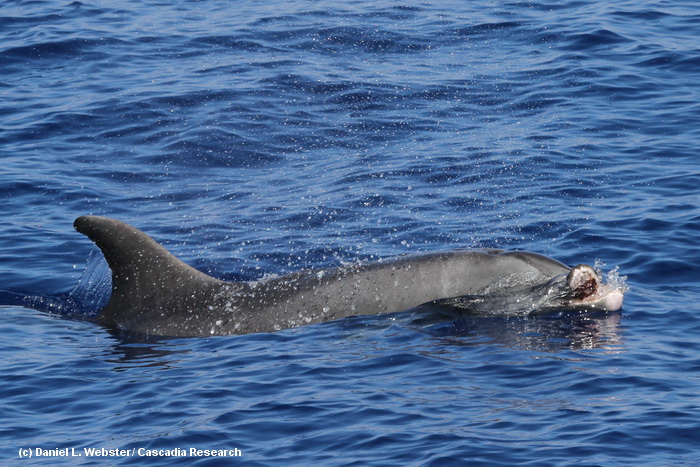
A common bottlenose dolphin with an injured rostrum, August 12, 2012. Photo (c) Daniel Webster. We also encountered several groups of bottlenose dolphins and were able to obtain identification photos of quite a few individuals, including this one with an injured rostrum.
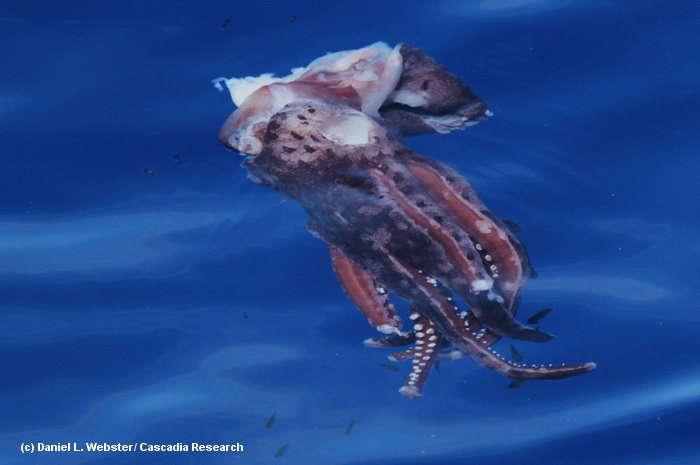
Our first squid for the trip, August 12, 2012. Photo (c) Daniel Webster.
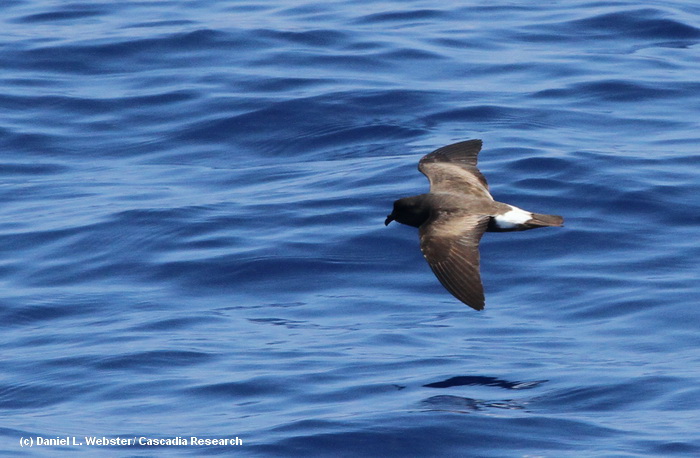
A band-rumped storm-petrel, August 12, 2012. Photo (c) Daniel Webster.
August 11th update
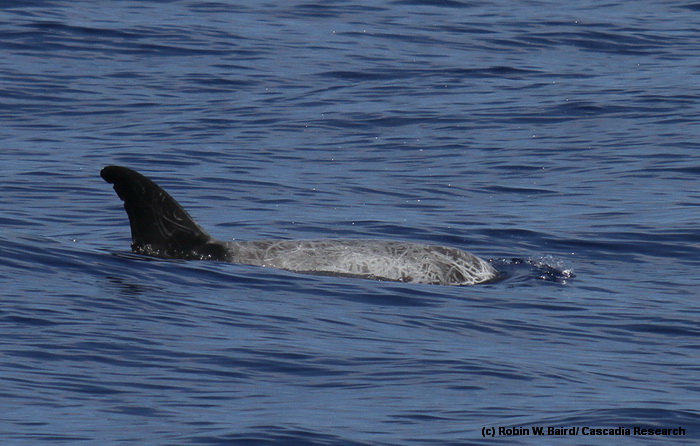
Risso’s dolphin, August 11, 2012 (c) Robin W. Baird. Today we encountered a group of about 25 Risso’s dolphins, only our eight encounter ever of Risso’s dolphins in Hawaii. This was the largest group of Risso’s we’ve encountered in Hawaii, and also the most cooperative. Although we were not able to get close enough to tag, we were able to photo-identify more than half the individuals present, and also obtain an acoustic recording of the group. For more information on Risso’s dolphins in Hawaii check out our web page on that species. Between the two boats we also encountered four different groups of pilot whales, and a pair of pygmy killer whales.
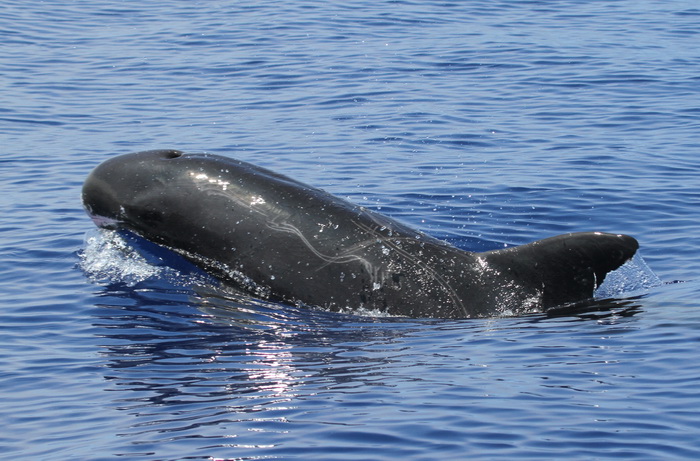
Pygmy killer whale, August 11, 2012 (c) Renee Albertson. The two pygmy killer whales encountered today are part of the resident population – one of the individuals was first seen off the island in 1988, and the two individuals, both adult males, have been seen together regularly since 2005.

Rough-toothed dolphins, August 10, 2012 (c) Robin W. Baird. Between the two boats today we had 11 encounters of four species, including bottlenose dolphins, rough-toothed dolphins, pilot whales, and pantropical spotted dolphins.
August 9th update
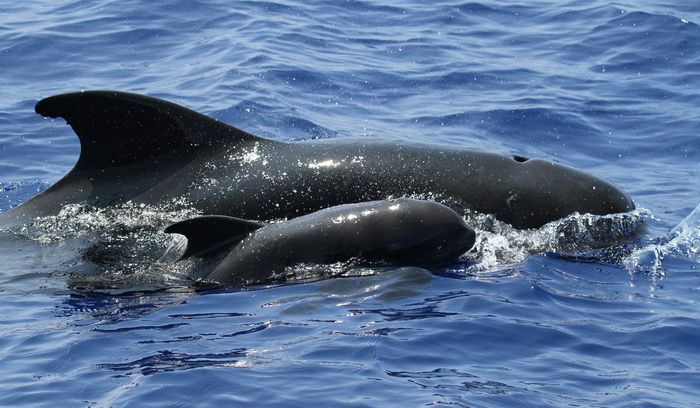
Short-finned pilot whale mother and newborn calf, August 9, 2012. Photo (c) Jeff Hogan. Our first day on the water today, and we encountered a group of about 30 pilot whales, including this mother and new born calf. We were able to photo-identify all the individuals present and get some underwater (GoPro) video footage. Tomorrow will be our first day out with both boats.
Photos below of our two research vessels
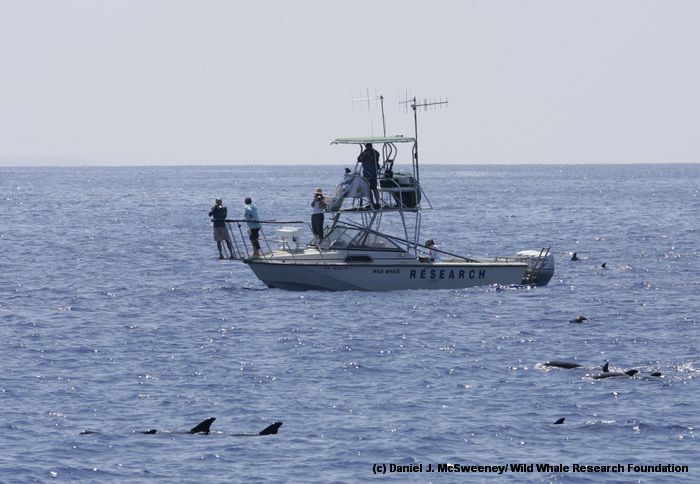
The R/V Wild Whale, a 27′ Boston Whaler, our primary research vessel, with a group of melon-headed whales. Photo from October 19, 2011, (c) Dan McSweeney.
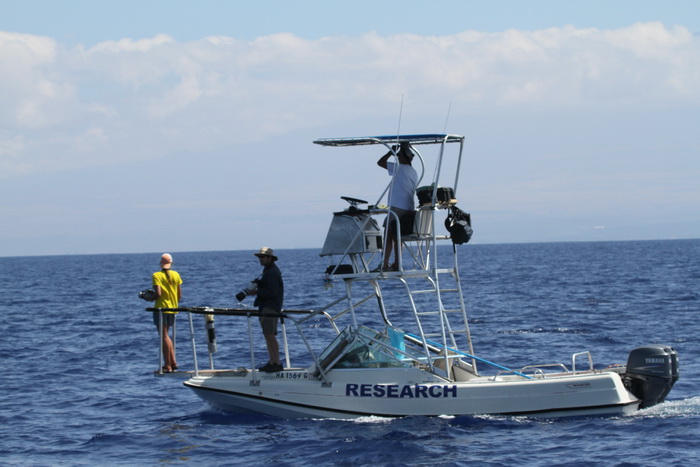
The R/V Black Whale, a 21′ Boston Whaler. Photo from October 19, 2011, (c) Sarah Mesnick.
Sign up to our Facebook page if you want to receive notices of when information is posted and updates on other Cascadia projects.